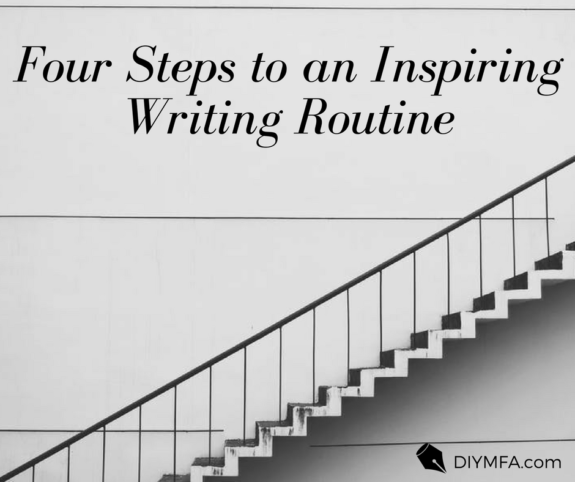Last year, I attended a national writing conference. I settled into my seat for the spotlight author interview, pencil poised, ready to absorb lessons from this New York Times bestselling author. The moderator pulled out his list of questions, smiled at the author, and said, “I promise I won’t ask where you get your ideas.”
I’m still not sure why this question is so taboo. The answer is simple. Ideas are found in the everyday: a snippet of conversation, a newspaper headline, a friendship gone bad. Life is filled with story fodder.
Of course, it’s not quite that easy. We all search for some magic key that unlocks the creativity floodgate in search for the idea that speaks to our soul. So we can create a story that we can look at proudly and say, I wrote this.
So how do we get there?
Routine.
Yes. I said routine. For me, I’ve discovered, there is a way to make my mind more receptive to ideas, to see the possibilities in the everyday. There is something magical that happens when I write, read, run, and repeat. I know. It sounds a lot like a washing machine cycle. But I promise there is something there. Let’s dive a little deeper, and you’ll see what I mean.
1) Write
If you listen to DIY MFA podcasts, Gabriela ends all her industry interviews with the same question: What is your number one tip for writers? And nine times out of ten her guest says: you need to write.
“The key to getting your book written,” says Pulitzer Prize-winner Stephen Hunter, “isn’t talent or luck or inspiration. It’s the act of sitting down every day and writing.”
Writer’s Write. That’s the cliff note version, anyway. And when I don’t write, my creativity atrophies just like muscles that need a workout. I prefer to write toward a goal (a word count, a short story, a novel), but prompts work too, anything that gets me to focus and create words. When I write consistently, it seems to fine-tune my senses. Things around me are richer, more vivid, and it opens up my imagination.
2) Read
“If you don’t have time to read, you don’t have the time (or the tools) to write. Simple as that,” says Stephen King.
For me, reading stimulates my mind. I need a minimum of thirty minutes per day. More is always better. My prose flows. I access ideas quicker. And I seem to see my project in a clearer way when I read.
I also subscribe to the DIY MFA tenet: Read With Purpose. For me, a novel is a teaching tool. I try to understand why I like a story or why I don’t; why a scene resonates or why it’s flat. And then I take what I learn and apply these lessons to my writing.
If a book is poorly written, I still dissect it to a point. But often times, I will put the book aside before I finish because I’ve discovered poor writing affects my craft too. If I read a book filled with passive voice then passive voice leaks into my prose. I find a story heavy on internalizations, and suddenly internalizations are slipping into my draft. Time is precious, and I don’t want to waste it reading something that doesn’t benefit craft or creativity in some way.
Audio books aren’t a substitute for reading for me, but I find they are a great resource too. Snappy dialogue stands out, and I can hear the cadence to a scene that sometimes gets lost when I read.
3) Run
Yes, I said run. I named this category run because I like the alliteration. But what I really mean is physical exercise: walking, hiking, anything that gets the blood flowing.
Kevin Loria from Business Insider writes, “We know that exercise, especially aerobic workouts like running, stimulates something called Brain Derived Neurotrophic Factor (BDNF), which encourages the growth of new brain cells in the hippocampus.”
The hippocampus is the part of the brain that controls creativity. Stanford University examined creativity levels of people when they walked versus when they sat and concluded a person’s creative output increased by an average of 60 percent when walking.
This concept has been true for me. During my run this weekend, I formulated a new series concept. I wasn’t looking for something new. And I never stepped off with this goal in mind. The idea found me because I had set conditions for success.
4) Repeat
That’s the thing about a routine. By definition it is a sequence of actions regularly followed. You need to repeat it. The key is to find a rhythm that works for you. I like to write in the morning when the house is quiet. So I get up early, run three miles, and write until my kids wake up. I respond to email and social media in the afternoon. And then read before I go to bed.
Certainly, life happens. My two year old wakes up when I do, or my six year old doesn’t go to bed on time. But this routine is my ideal, and I strive each day to achieve it.
Do you have a writing routine? How do you open your mind to new ideas?

Stacy Woodson is a U.S. Army Special Operations veteran and a self-declared fitness junkie. She loves a good conspiracy story and has penned one of her own. She believes in the power of a good writing community and how it can elevate your writing. She is a contributor to DIY MFA’s 5onFri and a Claymore finalist. She’s represented by John Talbot at the Talbot Fortune Agency.







